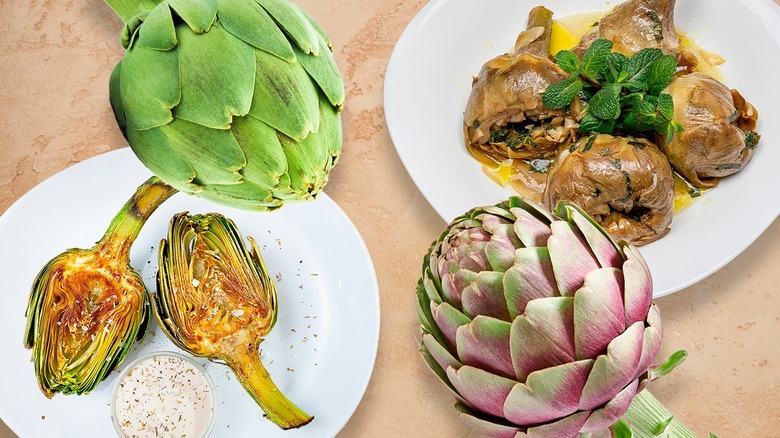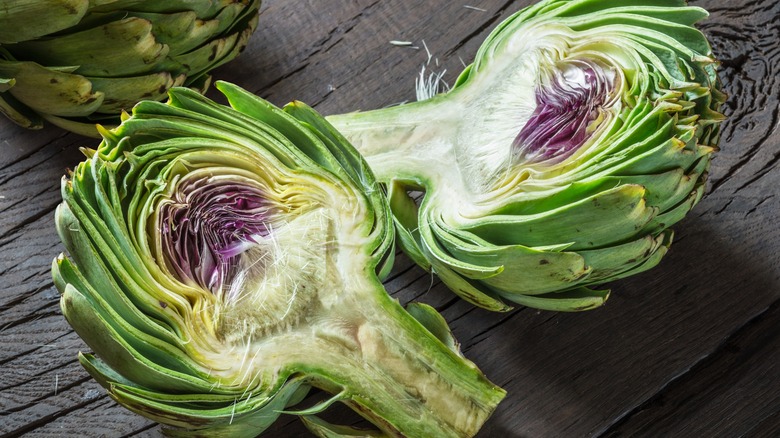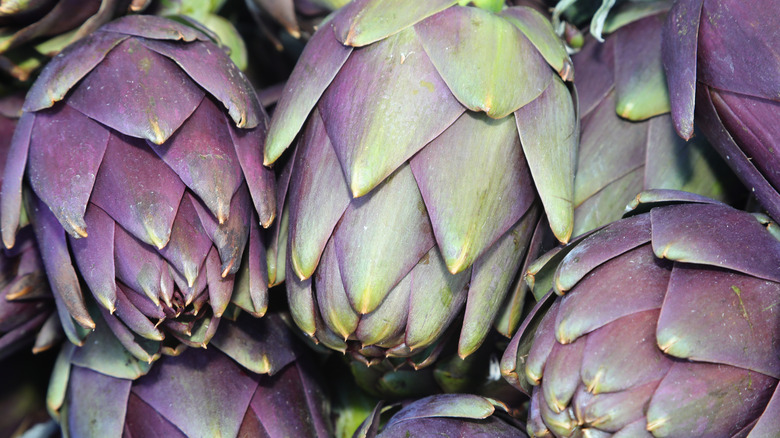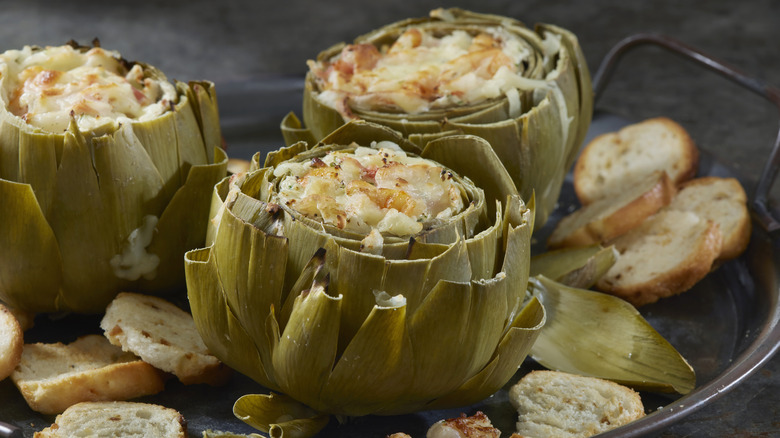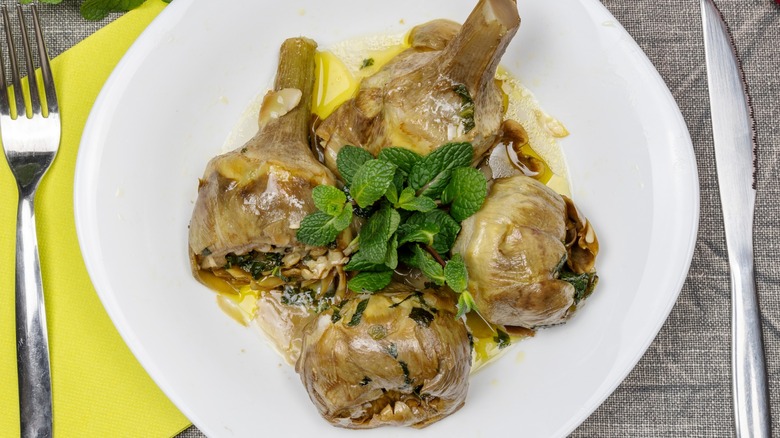The Difference Between American And Roman Artichokes
If you grew up in the U.S., the idea of eating artichokes may conjure images of the canned stuff. There's nothing wrong with choosing this option, per se, and in fact, there are times when you may want to use canned artichokes instead of the fresh version. But if you've limited your tastebuds simply to artichokes that come out of a tin, you're missing out on all the delicious ways these veggies are prepared and eaten around the world.
If you ever travel to Rome, you'll be amazed to see the humble artichoke transform into an especially yummy appetizer. But it's not just the way they're prepared that makes these veggies stand out in Italy — they actually use a different type of artichoke there. The main difference between these two artichokes is that, in the U.S., we tend to use a variety that requires us to suck the meat off the petals due to the tough leaves and prickly points. But in Italy, if you're doing as the Romans do, you'll be able to eat the entire veggie without the fear of poking yourself.
What are American artichokes?
In the U.S., we primarily eat globe artichokes, which are also known as French artichokes or by their scientific name, Cynara cardunculus var. scolymus. These are the ones you'll typically see at the grocery store — they're a sunny green color, can range in size (with the largest growing to about six inches in diameter), and have long stems. The petals on these veggies are pointy, and the inner layers reveal themselves to be light yellow or violet in color. If you ate their leaves raw (especially the ones on the outer layers), you'd find that they were tough and not very appetizing.
While we may call globe artichokes "American" today, they originally came from the Mediterranean and North Africa. To this day, Italy still produces the most artichokes worldwide. But of the ones grown in the U.S., the majority of them come from California, since the state has a climate that can somewhat match that of the Mediterranean. According to Specialty Produce, more than 80% of American commercial artichokes come from one seaside town called Castroville, which also claims to be the Artichoke Center of the World, and celebrates this honor with an annual festival centered around the veggies.
What are Roman artichokes?
Roman artichokes (Cynara scolymus 'Carciofo Romanesco') eliminate two of the most unsavory parts of the veggie: the sharp spines and the bristly choke. The former, also known as spikes or thorns, are the prickly tips of the bracts (sometimes called petals). They're technically edible, but not necessarily incredibly tasty — and we typically avoid them when we munch on artichokes in the U.S. The latter is the fuzzy center right above the prized heart of the veggie. While the heart is soft and yummy, the choke contains enough tough fibers that you wouldn't want to gnaw on it, so it's typically removed before the artichoke is cooked. With the Roman versions of these veggies, however, you can blissfully disregard these two elements.
Roman artichokes, also known as Carciofo Romanesco, mammola, or cimarolo, have existed in Europe since about 1400. They have vibrant purple petals, a grassy smell, and a soft center that's essentially fuzz-free. While this variety is grown occasionally in the U.S., particularly in California like its globe brethren, you'll mostly find it on the Italian coastline in Ladispoli and Cerveteri, two communes slightly north of Rome. And if you manage to get your hands on the Carciofo Romanesco del Lazio variety, you're in for a real treat, as these specific veggies have received Protected Geographical Indication (PGI) status.
American artichokes are typically stuffed, steamed, or canned
There are quite a few ways that you can prepare American artichokes — but again, they're mostly centered around making the soft heart and the vegetable meat on the petals as tasty as possible. Steaming the veggies is the classic way to cook them, which usually involves heating them in a steamer basket over the stove for about 40 minutes. However, you can also grill artichokes or bake them, or even steam them in the microwave if you're in a rush. Along with the choke, sometimes the tough outer leaves are removed before cooking, and the pointy spikes may be snipped off, too.
Artichokes in the U.S. are often enjoyed with simple flavorings, such as melted butter and lemon juice, to let the fresh veggies really shine. However, they can also be stuffed with Parmesan and breadcrumbs or a garlicky cheese sauce. Whichever toppings you use, you'll likely eat your cooked artichokes by peeling away the leaves, then sucking on them to pull off the bits of tender meat. For this reason, you may want to opt for canned versions if you want to incorporate them into a dish instead of eating them by themselves. In the U.S., they're often blended into the famous spinach artichoke dip or mixed into a vegan tuna salad.
Roman artichokes are usually braised or fried
If you've ever traveled to Italy, you may have been lucky enough to try carciofi alla Romana (aka Roman-style artichokes). As we've mentioned, Italians preparing this dish don't need to cut off the pointy thorns or dig out the choke, because these two elements don't exist with the same fervor in Roman artichokes. To make the dish, you'll need salt, pepper, white wine, lemons, garlic, olive oil, parsley, and mentuccia, a variety of calamint.
The seasonings, herbs, and olive oil are mixed together, then stuffed in between the petals of the veggies, which initially sit in a bath of water and lemon juice. Then, they get transferred to a pot with more oil and wine, in which they simmer for up to half an hour. By this time, they'll be soft enough that you can cut into them with a fork as they're served upside-down.
But if you're sampling these veggies in Rome, don't leave the city without trying its other delicacy: carciofi alla Guida, or, Roman-Jewish artichokes. Unlike the Romana version, you'd typically eat these with your hands, and their texture is similar to that of potato chips. You'd first remove the outer layer of petals, then dunk your veggies in a lemon water bath and beat them until the leaves open. Then, you would fry them twice — first at a lower heat to brown them and open their petals a little more, then again at a higher heat until they get nice and crispy.
